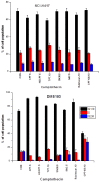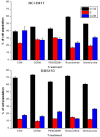Synergism of cyclin-dependent kinase inhibitors with camptothecin derivatives in small cell lung cancer cell lines
- PMID: 24549232
- PMCID: PMC6271949
- DOI: 10.3390/molecules19022077
Synergism of cyclin-dependent kinase inhibitors with camptothecin derivatives in small cell lung cancer cell lines
Abstract
Advanced small cell lung cancer (SCLC) has a dismal prognosis. Modulation of the camptothecin topotecan, approved for second-line therapy, may improve response. Our recent finding of synergistic enhancement of the cytotoxic activity of camptothecin (CPT) by cyclin-dependent kinase 4 inhibitors is extended here to a panel of camptothecin analogs comprising 10-hydroxy-CPT (HOCPT), topotecan (TPT; 9-[(dimethylamino)-methyl]-10-hydroxy-CPT), 9-amino-CPT (9AC), 9-nitrocamptothecin (rubitecan), SN38 (7-ethyl-10-hydroxycamptothecin) and 10-hydroxy-9-nitrocamptothecin (CPT109) in combination with PD0332991, CDK4I, roscovitine and olomoucine. SCLC cell lines employed are chemoresistant NCI-H417 and DMS153 and the chemosensitive SCLC26A line established at our institution. The CPT analogs exhibiting highest cytotoxicity towards the three SCLC lines tested were SN38 and 9AC, followed by rubitecan, HOCPT, TPT and CPT109. NCI-H417 and DMS153 revealed an approximately 25-fold and 7-fold higher resistance compared to the chemosensitive SCLC26A cell line. Whereas the CDK4/6 inhibitor PD0332991 proved less effective to chemosensitize SCLC cells to CPT analogs, the CDK inhibitors CDK4I, roscovitine and olomoucine gave comparable chemosensitization effects in combination with 9AC, SN38, rubitecan and to a lesser extent with TPT and CPT109, not directly related with topoisomerase mRNA expression. In conclusion, small chemical modifications of the parent CPT structure result in differing cytotoxicities and chemomodulatory effects in combination with CDKIs of the resulting analogs.
Conflict of interest statement
The authors declare no conflict of interest.
Figures







Similar articles
-
Extended topoisomerase 1 inhibition through liposomal irinotecan results in improved efficacy over topotecan and irinotecan in models of small-cell lung cancer.Anticancer Drugs. 2017 Nov;28(10):1086-1096. doi: 10.1097/CAD.0000000000000545. Anticancer Drugs. 2017. PMID: 28857767
-
Cytotoxic effects of fascaplysin against small cell lung cancer cell lines.Mar Drugs. 2014 Mar 7;12(3):1377-89. doi: 10.3390/md12031377. Mar Drugs. 2014. PMID: 24608973 Free PMC article.
-
Synergistic antitumor effect between vorinostat and topotecan in small cell lung cancer cells is mediated by generation of reactive oxygen species and DNA damage-induced apoptosis.Mol Cancer Ther. 2009 Nov;8(11):3075-87. doi: 10.1158/1535-7163.MCT-09-0254. Epub 2009 Nov 3. Mol Cancer Ther. 2009. PMID: 19887547
-
Pharmacology of topoisomerase I inhibitors irinotecan (CPT-11) and topotecan.Curr Cancer Drug Targets. 2002 Jun;2(2):103-23. doi: 10.2174/1568009023333890. Curr Cancer Drug Targets. 2002. PMID: 12188913 Review.
-
Camptothecin analogues in the treatment of non-small cell lung cancer.Lung Cancer. 1995 Apr;12 Suppl 1:S177-85. doi: 10.1016/0169-5002(95)00434-3. Lung Cancer. 1995. PMID: 7551927 Review.
Cited by
-
Palbociclib in Solid Tumor Patients With Genomic Alterations in the cyclinD-cdk4/6-INK4a-Rb Pathway: Results From National Cancer Institute-Children's Oncology Group Pediatric Molecular Analysis for Therapy Choice Trial Arm I (APEC1621I).JCO Precis Oncol. 2024 Sep;8:e2400418. doi: 10.1200/PO-24-00418. JCO Precis Oncol. 2024. PMID: 39298716 Clinical Trial.
-
Comparative characteristics of small cell lung cancer and Ewing's sarcoma: a narrative review.Transl Lung Cancer Res. 2022 Jun;11(6):1185-1198. doi: 10.21037/tlcr-22-58. Transl Lung Cancer Res. 2022. PMID: 35832443 Free PMC article. Review.
-
Camptothecin inhibits the progression of NPC by regulating TGF-β-induced activation of the PI3K/AKT signaling pathway.Oncol Lett. 2018 Jul;16(1):552-558. doi: 10.3892/ol.2018.8688. Epub 2018 May 10. Oncol Lett. 2018. PMID: 29963130 Free PMC article.
-
Chemotherapy and CDK4/6 Inhibitors: Unexpected Bedfellows.Mol Cancer Ther. 2020 Aug;19(8):1575-1588. doi: 10.1158/1535-7163.MCT-18-1161. Epub 2020 Jun 16. Mol Cancer Ther. 2020. PMID: 32546660 Free PMC article. Review.
-
Cyclin-dependent kinase 5 negatively regulates antiviral immune response by disrupting myeloid differentiation primary response protein 88 self-association.Virulence. 2023 Dec;14(1):2223394. doi: 10.1080/21505594.2023.2223394. Virulence. 2023. PMID: 37332205 Free PMC article.
References
-
- Tomicic M.T., Kaina B. Topoisomerase degradation, DSB repair, p53 and IAPs in cancer cell resistance to camptothecin-like topoisomerase I inhibitors. Biochim. Biophys. Acta. 2013;1835:11–27. - PubMed
Publication types
MeSH terms
Substances
LinkOut - more resources
Full Text Sources
Other Literature Sources

